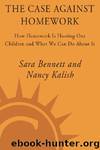The Case Against Homework: How Homework Is Hurting Our Children and What We Can Do About It by Sara Bennett & Nancy Kalish

Author:Sara Bennett & Nancy Kalish [Bennett, Sara]
Language: eng
Format: mobi
Publisher: Crown Publishing Group
Published: 2006-08-29T04:00:00+00:00
TYPICAL ASSIGNMENT
Read chapter 3 in your science (or social studies) textbook, then answer the questions at the end.
In both social studies and science (assuming they haven’t been cut from your school’s curriculum in order to focus solely on standardized tests subjects), the typical homework is to read the textbook and answer factual questions. Unfortunately, this rarely engages kids, and it’s unlikely to help them remember facts.
“If a homework assignment extends the learning and makes kids really think about the topic, then it can be valuable,” says Beers. But asking kids to answer questions at the end of a chapter simply encourages them to “skim and scan” as they’ve learned to do with other reading assignments. And when kids are reading solely to find particular facts, they’re not delving deeper. “Even good students don’t read the chapter. They hunt in the text for the answers,” says Andrea Libresco, associate professor of Curriculum and Teaching at Hofstra University School of Education. “Worse, such assignments ignore a kid’s biggest question, which is, Why should I care about this topic? Teachers are at fault for training our kids to find disparate pieces of information to which they make no emotional connection.” Without that connection, little true learning is going on. As Gilly, a seventh-grade history teacher from New York City, puts it, “Reading a textbook chapter and answering questions at the end is a waste of students’ time. They don’t remember anything they ‘learned,’ and they don’t even practice good study habits.”
As kids get older, some copy answers from one another. Erin, a high school teacher from Brandon, Florida, observes, “One person does the work and everyone else copies before school. I am amazed at the ease with which students pass their work around. Many do not even bother to rephrase statements to make answers seem less copied.”
So, how did we get to this point? According to Professor Libresco, teachers were probably taught social studies and science the same way when they were children. So they are just continuing an unfortunate tradition of “if it’s Tuesday, it’s chapter 1, so answer these questions, do this worksheet.” And today, many teachers are supplied with so-called pacing guides that plan every lesson down to the minute. If the teacher doesn’t finish the lesson, it must be finished at home—without her guidance—and a new one started the next day. Unfortunately, with this method, kids don’t get much chance to practice their analytical skills. Do they even remember the facts? Try asking a student to repeat them a month after the unit test and you’ll get your answer.
Download
This site does not store any files on its server. We only index and link to content provided by other sites. Please contact the content providers to delete copyright contents if any and email us, we'll remove relevant links or contents immediately.
The Lost Art of Listening by Michael P. Nichols(7411)
Rich Dad Poor Dad by Robert T. Kiyosaki(6413)
We Need to Talk by Celeste Headlee(5547)
I Love You But I Don't Trust You by Mira Kirshenbaum(3810)
The Complete Idiot's Guide to Coping With Difficult People by Arlene Uhl(3118)
Rich Dad Poor Dad: What The Rich Teach Their Kids About Money - That The Poor And Middle Class Do Not! by Robert T. Kiyosaki(2909)
A Burst of Light by Audre Lorde(2548)
The Book You Wish Your Parents Had Read (and Your Children Will Be Glad That You Did) by Philippa Perry(2454)
Dealing with People You Can't Stand by Dr. Rick Brinkman(2433)
Life Hacks by Dan Marshall(2418)
An Odyssey by Daniel Mendelsohn(2263)
The Expectant Father by Armin A. Brott & Jennifer Ash(2219)
Teach Your Child How to Think by Edward De Bono(2134)
No Time to Say Goodbye(2063)
What I Need by J. Daniels(2028)
The 7 Habits Of Highly Effective Teens by Covey Sean(2026)
The Out-of-Sync Child by Carol Stock Kranowitz(2022)
I Don't Belong to You by Keke Palmer(1956)
The Self-Driven Child by William Stixrud PhD & Ned Johnson(1922)
